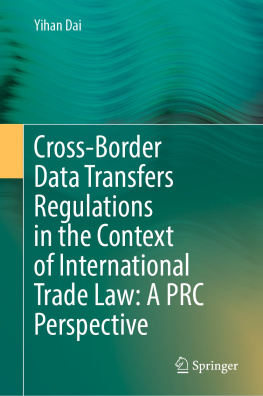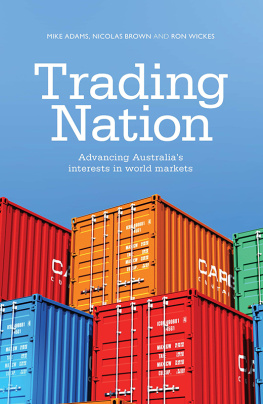Contents
List of Figures
List of Tables
Guide
Pagebreaks of the print version

The Ohlin Lectures
Protectionism, Jagdish Bhagwati
Economic Stabilization and Debt in Developing Countries, Richard N. Cooper
Unemployment and Macroeconomics, Assar Lindbeck
Political Economy of Policy Reform in Developing Countries, Anne O. Krueger
Factor Proportions, Trade, and Growth, Ronald Findlay
Development, Geography, and Economic Theory, Paul Krugman
Unintended Consequences: The Impact of Factor Endowments, Culture, and Politics on Long-Run Economic Performance, Deepak Lal
Globalization and the Theory of Input Trade, Ronald W. Jones
Too Sensational: On the Choice of Exchange Rate Regimes, W. Max Corden
Globalization and the Poor Periphery before 1950, Jeffrey G. Williamson
The Development and Testing of Heckscher-Ohlin Trade Models: A Review, Robert E. Baldwin
Offshoring in the Global Economy: Microeconomic Structure and Macroeconomic Implications, Robert C. Feenstra
Trade Policy Disaster: Lessons from the 1930s, Douglas A. Irwin
The Craft of Economics: Lessons from the Heckscher-Ohlin Framework, Edward E. Leamer
Macroeconomics in Times of Liquidity Crises: Searching for Economic Essentials, Guillermo Calvo
A World Trading System for the Twenty-First Century, Robert W. Staiger
See https://mitpress.mit.edu for a complete list of titles in this series.
A World Trading System for the Twenty-First Century
Robert W. Staiger
The MIT Press
Cambridge, Massachusetts
London, England
2022 Massachusetts Institute of Technology
This work is subject to a Creative Commons CC-BY-NC-ND license.
Subject to such license, all rights are reserved.

The MIT Press would like to thank the anonymous peer reviewers who provided comments on drafts of this book. The generous work of academic experts is essential for establishing the authority and quality of our publications. We acknowledge with gratitude the contributions of these otherwise uncredited readers.
Library of Congress Cataloging-in-Publication Data
Names: Staiger, Robert W., author.
Title: A world trading system for the twenty-first century / Robert W. Staiger.
Description: Cambridge, Massachusetts: The MIT Press, [2022] | Series: Ohlin lectures | Includes bibliographical references and index.
Identifiers: LCCN 2022000723 (print) | LCCN 2022000724 (ebook) | ISBN 9780262047302 (hardcover) | ISBN 9780262371292 (pdf) | ISBN 9780262371308 (epub)
Subjects: LCSH: International economic relations. | Commercial treaties. | Foreign trade regulation. | Foreign trade regulationDeveloping countries. | Globalization.
Classification: LCC HF1365.S73 2022 (print) | LCC HF1365 (ebook) | DDC 337.1dc23/eng/20220310
LC record available at https://lccn.loc.gov/2022000723
LC ebook record available at https://lccn.loc.gov/2022000724
d_r0
To Sally, again
And in memory of my father, David S. Staiger,
February 2, 1928December 10, 2019
Contents
List of Figures
The rise of emerging market and developing economies. Gross domestic product measured at purchasing power parity as a percent of world. Source: Created from IMF DataMapper with data from IMF (2017).
The rise of offshoring. Source: From Business Insider, https://www.businessinsider.com/. 2017 Insider Inc.. All rights reserved. Used under license.
A closed economy.
The gains from trade.
A small countrys unilateral tariff choice.
A large countrys unilateral tariff choice.
The relationship between market power and unilateral tariff choices. HS denotes Harmonized System product classification. Source: Broda, Limo, and Weinstein (2008, figure 3).
A large countrys tariff choice in the presence of reciprocity.
The relationship between market power and the tariff cuts that countries agree to when they join the WTO. Source: Bagwell and Staiger (2011, figure 2).
Percent deviation from mean concession by mBR decile. Source: Reproduced from Bagwell and Staiger (2011, fig. 1).
Percent deviations from mean concessions by BR decile. Source: Reproduced from Bagwell and Staiger (2011, fig. 2).
Efficient tariffs. Source: Adapted from Bagwell and Staiger (2005, fig. 1).
Nash-in-Nash equilibrium tariffs.
The rise of global value chains. Source: Reproduced from World Bank (2020, fig. 2).
Source: Reproduced from Antrs and Staiger (2012a, fig. 1).
Source: Based on the results of Laget et al. (2019) and reproduced from the 2020 World Development Report (World Bank, 2020, fig. 9.9).
The unilateral incentive for regulatory protectionism. Source: Reproduced from Grossman, McCalman, and Staiger (2021, figure 1).
The participation benefits of a rules-based system. W = welfare of the domestic country, W* = welfare of the foreign country, NP = Nash product, RB = rules-based bargaining outcome, PB = power-based bargaining outcome, S = politically optimal outcome. Source: Adapted from Bagwell and Staiger (1999, fig. 5B).
Hegemonic transition of the world trading system. Source: Reproduced from Mattoo and Staiger (2020, fig. 2).
List of Tables
GATT old-timers.
GATT newcomers.
Preface
The multilateral trading system is in trouble. Governed by the World Trade Organization (WTO), which came into existence in 1995 and builds on and extends the principles of its twentieth-century predecessor agreement, the General Agreement on Tariffs and Trade (GATT), this system of global trade rules is facing a growing list of twenty-first-century challenges that include the rise of large emerging markets led by China, efforts to address climate change, the growing importance of digital trade, the rise of offshoring and global value chains, and the push for regulatory harmonization as an end in itself. These challenges reflect changes in the global economy that have occurred in recent decades, and they raise questions about the legitimacy of the GATT/WTO as the arbiter of global trade rules. Is the WTO, an institution that has traditionally been about shallow integration with a focus on trade impediments imposed at the border rather than on deep integration that results from direct negotiations over behind-the-border measures, capable of meeting these challenges? Or do we need a new global trade order for the twenty-first century?
In this book I address these questions, arguing that the best hope for creating an effective world trading system for the twenty-first century is to build on the foundations of the world trading system of the twentieth century. I construct this argument in two steps: first, by developing an understanding of why GATT worked and the economic environment it is best suited for (part I), and second, by evaluating from the perspective of this understanding whether the changes in the global economy that have occurred in recent decades imply the need for changes in the design of the GATT/WTO (part II). Throughout I adopt the view that design should reflect purpose, and that identifying the fundamental purpose of a trade agreement in a given economic environmentthat is, what problem the agreement should solve for the member governmentsis essential to understanding its appropriate design in that environment. Building on these steps, I argue that the terms-of-trade theory of trade agreements provides a compelling framework for understanding the purpose of a trade agreement in the twentieth century and the success of GATT. I further argue that according to this understanding, the logic of GATTs design features transcend many, though not all, of the current challenges faced by the WTO (part III).










